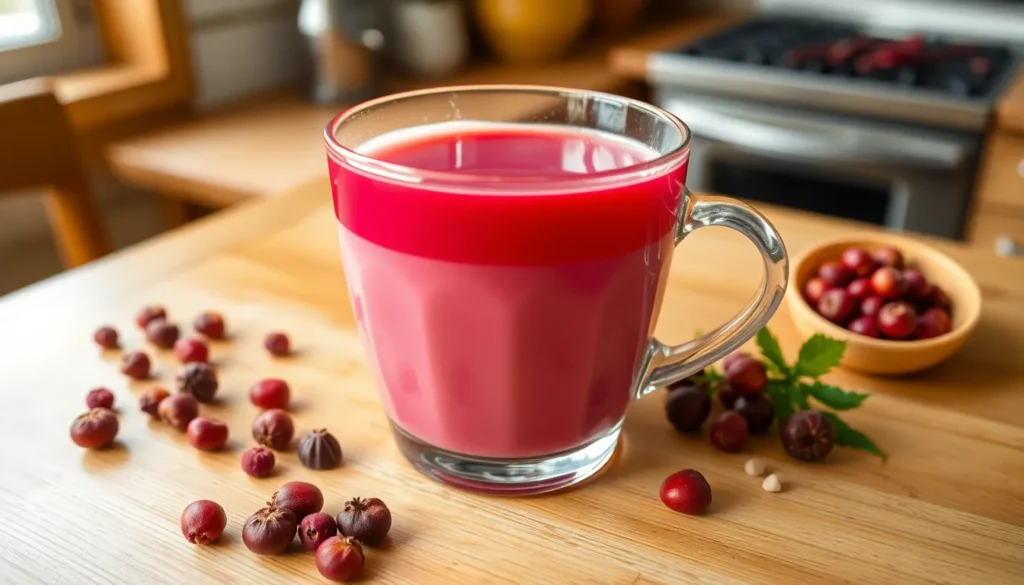We’ve discovered a hidden gem that’s about to transform your tea routine forever. Rosehip milk tea combines the tart sweetness of vitamin C-packed rosehips with creamy, comforting milk for a drink that’s both nourishing and utterly delicious. This Nordic-inspired beverage has been warming hearts across Scandinavia for generations, and now it’s time to bring this cozy tradition into your kitchen.
What makes this tea truly special isn’t just its gorgeous ruby-red color or its delicate floral notes – it’s the incredible health benefits packed into every sip. Rosehips contain more vitamin C than oranges, making this the perfect immune-boosting drink for chilly mornings or afternoon pick-me-ups.
We’ll show you exactly how to create this Instagram-worthy beverage that tastes like a warm hug in a mug. Trust us, once you try this creamy, aromatic blend, you’ll wonder why rosehip milk tea isn’t already a staple in your daily routine.
What Is Rosehip Milk Tea
Rosehip milk tea blends the distinctive tartness of rosehips with the smooth richness of steamed milk to create a uniquely satisfying beverage. We transform dried rosehip berries into a vibrant infusion that forms the foundation of this Nordic inspired drink. The natural sweetness of rosehips balances beautifully with their subtle tanginess while the milk adds body and creates a luxurious mouthfeel.
This warming beverage showcases rosehips in their most approachable form for those unfamiliar with these ruby red fruits. We steep the dried berries to extract their concentrated flavor and essential nutrients before combining them with our choice of milk. The resulting drink delivers a gorgeous coral hue that makes every cup visually striking.
Rosehip milk tea offers a caffeine free alternative to traditional tea lattes while providing substantial nutritional benefits. We appreciate how this drink bridges the gap between herbal wellness and indulgent comfort beverages. The preparation process allows us to control both the strength of the rosehip flavor and the creaminess level to suit individual preferences.
Traditional Nordic cultures have long valued rosehips for their medicinal properties and now we can enjoy these benefits in an accessible modern format. The drink works equally well as a morning energizer or an evening wind down beverage. We find that rosehip milk tea satisfies cravings for something both nourishing and delicious without overwhelming sweetness or artificial flavors.
Health Benefits of Rosehip Milk Tea
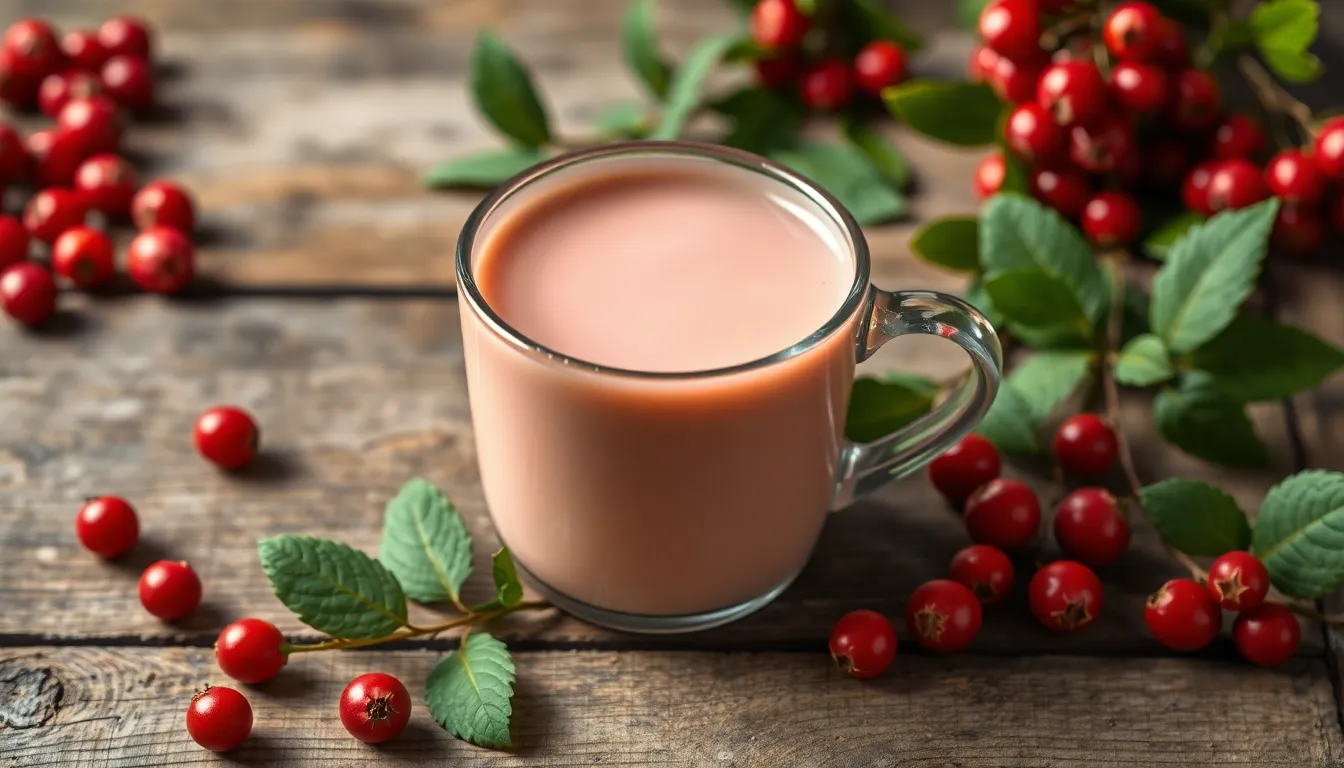
We’re excited to share the impressive health benefits that make rosehip milk tea more than just a delicious beverage. Our favorite Nordic-inspired drink delivers substantial nutritional value alongside its comforting taste and vibrant appearance.
Exceptional Vitamin C Content
Rosehips rank among the highest natural sources of vitamin C available to us. We benefit from this powerful nutrient that supports immune function, promotes healthy skin, and prevents vitamin C deficiencies. The concentration of vitamin C in rosehips surpasses many traditional citrus fruits, making our rosehip milk tea an exceptional choice for daily nutrition.
Immune System Support
Our bodies receive important immune support from the high vitamin C and antioxidant content found in rosehips. We can rely on these compounds to strengthen our natural defenses and potentially reduce both the duration and severity of colds and flu. Regular consumption helps maintain our immune system’s optimal performance throughout seasonal changes.
Powerful Antioxidant Protection
Rosehip tea provides us with polyphenols and flavonoids that actively eliminate free radicals and reduce oxidative stress. We benefit from this cellular protection that supports our overall health and helps combat the effects of environmental stressors. These antioxidants work continuously to maintain our body’s natural defense mechanisms.
Cardiovascular Health Benefits
Research shows us that rosehip extract supports heart health through multiple pathways. We experience benefits from its ability to help lower cholesterol levels and modulate blood pressure, which contributes to cardiovascular disease prevention. Our circulatory system receives ongoing support from the bioactive compounds present in rosehips.
Digestive System Support
Traditional uses of rosehip tea include supporting healthy digestion, and we gain additional benefits when combined with milk. The enzymes and probiotics found in dairy products may enhance our digestive processes. We appreciate how this combination creates a soothing effect on our digestive system while providing nutritional support.
Anti-Inflammatory Properties
We benefit from rosehip’s natural anti-inflammatory compounds that may help reduce pain and discomfort. Joint pain and inflammatory conditions respond positively to regular consumption of rosehip preparations. Our bodies receive gentle, natural support for managing inflammation without harsh side effects.
Energy and Recovery Enhancement
Rosehip serves as our natural remedy for fatigue and supports recovery from illness or exhaustion. We find that regular consumption helps maintain energy levels and promotes faster healing processes. Our overall vitality receives a boost from the nutrient-dense profile of rosehips combined with the protein and calcium from milk.
Ingredients
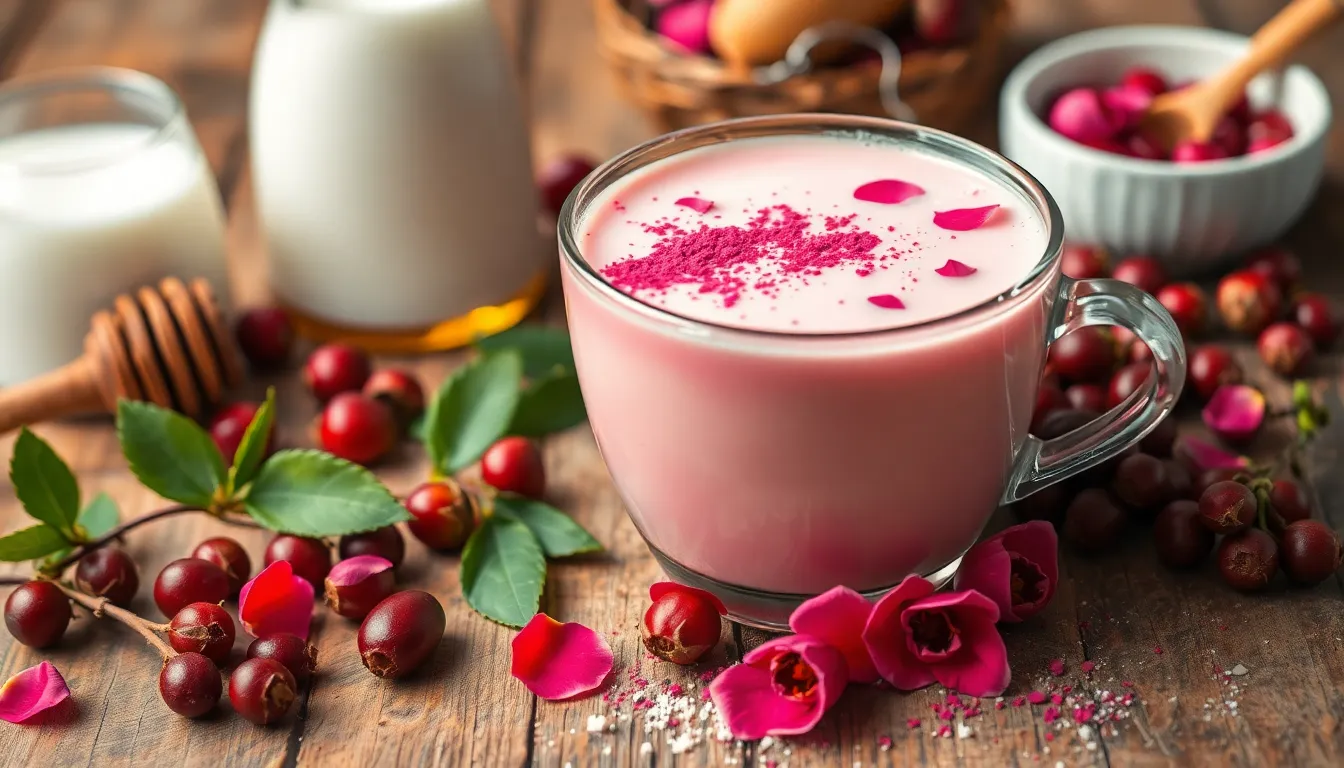
Creating the perfect rosehip milk tea requires quality ingredients that balance tartness with creamy richness. We’ve organized our ingredient list into three categories to help you prepare this nutritious beverage efficiently.
For the Rosehip Base
- 2 teaspoons rosehip powder or 1-2 tablespoons dried rosehips for a strong infusion
- 1 cup boiling water
- 2 teaspoons raw honey, sugar, or alternative sweetener to taste
For the Milk Tea
- 2 cups milk (dairy, almond, oat, or any preferred type)
- 2 teaspoons rooibos tea leaves or any tea of choice for added flavor (optional but recommended for deeper taste)
Optional Add-ins
- ½ teaspoon rose petal powder for garnish and aroma
- Tapioca pearls (boba) for bubble tea texture
- Splash of vanilla extract or vanilla bean for enhanced flavor
- Ice cubes for a chilled version
Equipment Needed

Creating the perfect rosehip milk tea requires basic kitchen tools that most home cooks already have on hand. We’ll walk you through each essential item and explain how it contributes to brewing this delightful beverage.
Tea Infuser or Fine Mesh Strainer serves as our primary tool for steeping rosehips and extracting their vibrant color and nutrients. A tea infuser allows dried rosehips to release their tart flavors while keeping particles contained for easy removal. Fine mesh strainers work equally well when brewing larger batches or using rosehip powder.
Kettle or Saucepan heats water to the optimal temperature for rosehip extraction. Electric kettles offer convenience and temperature control while stovetop kettles provide traditional brewing charm. Water should reach a rolling boil to fully activate the vitamin C and antioxidants locked within the rosehips.
Measuring Cups and Spoons ensure accurate proportions between rosehips and water for consistent flavor strength. Precise measurements help achieve the perfect balance between tartness and smoothness that makes rosehip milk tea so appealing.
Serving Cups or Mugs showcase the beautiful ruby red color of your finished beverage. Clear glass mugs highlight the drink’s vibrant appearance while ceramic cups retain heat longer for extended enjoyment.
Mixing Spoon blends the rosehip tea with milk and sweeteners for uniform flavor distribution. A long handled spoon reaches the bottom of tall mugs and prevents splashing during the combining process.
Milk Frother or Small Whisk creates the creamy texture that elevates rosehip milk tea from simple herbal drink to café style beverage. Frothing incorporates air into the milk and produces the luxurious mouthfeel that complements the rosehips’ natural tartness.
| Equipment | Purpose | Alternative Options |
|---|---|---|
| Tea Infuser | Steep rosehips cleanly | Fine mesh strainer, cheesecloth |
| Kettle | Heat water efficiently | Saucepan, microwave |
| Measuring Tools | Ensure consistent ratios | Kitchen scale for weight measurements |
| Serving Cup | Present finished beverage | Any heat-safe drinking vessel |
| Mixing Spoon | Combine ingredients | Any long handled utensil |
| Milk Frother | Create creamy texture | French press, jar with lid |
Most home kitchens contain these basic tools already. The beauty of rosehip milk tea lies in its simplicity and accessibility using everyday equipment.
Instructions

Creating our perfect rosehip milk tea requires three essential steps that transform dried rosehips into a luxurious beverage. We’ll guide you through each stage to ensure optimal flavor extraction and a beautifully balanced final drink.
Preparing the Rosehip Base
We begin by selecting high-quality dried rosehips from health food stores or herbal shops for the best flavor profile. Measure 2 teaspoons of rosehip powder or 1-2 tablespoons of dried rosehips per serving depending on your preferred strength. If using whole dried rosehips, we recommend crushing them lightly to release more flavor compounds during steeping.
Optional floral elements like hibiscus can be blended with rosehips at this stage for added depth and complexity. We prepare this base mixture before heating any water to ensure all ingredients are ready for the brewing process.
Brewing the Tea
We start by boiling one cup of water per serving in our kettle or saucepan. Once the water reaches a rolling boil, we add our prepared rosehip mixture to the hot water using a tea infuser or directly into the pot. Allow the rosehips to steep for 5-10 minutes depending on desired strength preferences.
| Steeping Time | Flavor Intensity |
|---|---|
| 5 minutes | Light, delicate |
| 7-8 minutes | Medium strength |
| 10 minutes | Bold, robust |
We strain the liquid thoroughly using a fine mesh strainer to remove all solids and achieve a smooth base. The resulting infusion should display a vibrant ruby-red color characteristic of properly brewed rosehip tea.
Combining and Serving
We sweeten our strained rosehip tea to taste using honey or sugar while the liquid remains warm for easy dissolution. Heat 2 cups of milk separately in a saucepan until steaming, or use a milk frother to create a luxurious foam texture.
Pour the warm frothed milk into our rosehip tea, stirring gently to combine the flavors. We can enhance the aroma by adding rosehip syrup or rose syrup at this stage for intensified floral notes. Serve immediately while hot for the traditional experience, or chill the mixture and serve over ice for a refreshing cold version.
For bubble tea enthusiasts, we cook tapioca pearls separately according to package instructions before adding them to the finished drink. Store any leftover rosehip tea or syrup in airtight containers in the refrigerator for up to several weeks.
Directions for Iced Rosehip Milk Tea

We transform our hot rosehip milk tea into a refreshing iced version perfect for warm weather or when you crave something cool and invigorating. This chilled variation maintains all the nutritional benefits while delivering a crisp and satisfying experience.
Step 1: Prepare the Rosehip Base
We begin by steeping 2 teaspoons of rosehip powder or 1-2 tablespoons of dried rosehips in 1 cup of boiling water. Allow the mixture to steep for 8-10 minutes to extract maximum flavor and nutrients. The longer steeping time helps create a more concentrated base that won’t become diluted when served over ice.
Step 2: Strain and Sweeten
We strain the rosehip infusion through a fine mesh strainer to remove any particles. Add your preferred sweetener while the tea is still warm to ensure complete dissolution. Honey or maple syrup work particularly well with the tart rosehip flavor.
Step 3: Chill the Tea
We transfer the sweetened rosehip tea to the refrigerator and let it chill for at least 30 minutes. For faster cooling, we place the container in an ice bath for 10-15 minutes while stirring occasionally.
Step 4: Prepare the Milk Component
We pour 1 cup of cold milk into a separate container. If desired, we can create a light milk foam using a milk frother or by whisking vigorously for 1-2 minutes. This adds a luxurious texture to the final drink.
Step 5: Assemble the Iced Tea
We fill a tall glass with ice cubes and pour the chilled rosehip tea over the ice. Slowly add the cold milk, creating beautiful layers. Top with the milk foam if prepared, and gently stir before serving.
Step 6: Customize and Serve
We can enhance our iced rosehip milk tea with optional additions like tapioca pearls, a dash of vanilla extract, or a sprinkle of rose petal powder. The drink is best enjoyed immediately while the ice maintains the perfect temperature balance.
| Nutritional Information | Per Serving |
|---|---|
| Calories | 260 |
| Carbohydrates | 60g |
| Fat | 2g |
| Protein | 1g |
Our iced rosehip milk tea delivers the same impressive health benefits as the hot version, including high vitamin C content for immune support and powerful antioxidants for overall wellness. The cold preparation method preserves these beneficial compounds while creating a refreshing beverage perfect for any time of day.
Make-Ahead Tips

We can streamline our rosehip milk tea preparation by preparing several components in advance. This approach saves time during busy mornings and ensures we always have this nutritious beverage ready to enjoy.
Rosehip Tea Base Preparation
Our rosehip tea concentrate stores beautifully in the refrigerator for up to one week. We steep dried rosehips in boiling water for 4 to 15 minutes according to our taste preferences then strain the mixture completely. The concentrated tea base should be stored in an airtight glass container in the refrigerator. When we’re ready to serve, we simply dilute this concentrate with hot or cold milk depending on our preference.
Sweetener Syrup Storage
Preparing sweetener syrups ahead of time eliminates the hassle of dissolving granulated sugar during service. We can make honey simple syrup or sugar syrup in batches and store them in the refrigerator for future use. These syrups blend seamlessly into both hot and cold versions of our rosehip milk tea.
Milk Component Tips
Fresh milk should be warmed and frothed just before serving to maintain optimal flavor and texture. We avoid preparing milk components too far in advance as this can affect the drink’s creamy mouthfeel. For iced versions, we can pre-chill our preferred milk in the refrigerator.
Batch Preparation Strategy
| Component | Storage Time | Storage Method |
|---|---|---|
| Rosehip tea concentrate | 7 days | Refrigerator, airtight container |
| Sweetener syrup | 2 weeks | Refrigerator, sealed bottle |
| Prepared iced tea | 3 days | Refrigerator, covered pitcher |
Serving Optimization
We recommend preparing individual serving portions of rosehip concentrate in ice cube trays for quick single-serve preparation. Each cube represents one serving of concentrate that we can quickly combine with warm milk for an instant rosehip milk tea experience.
Storage Instructions
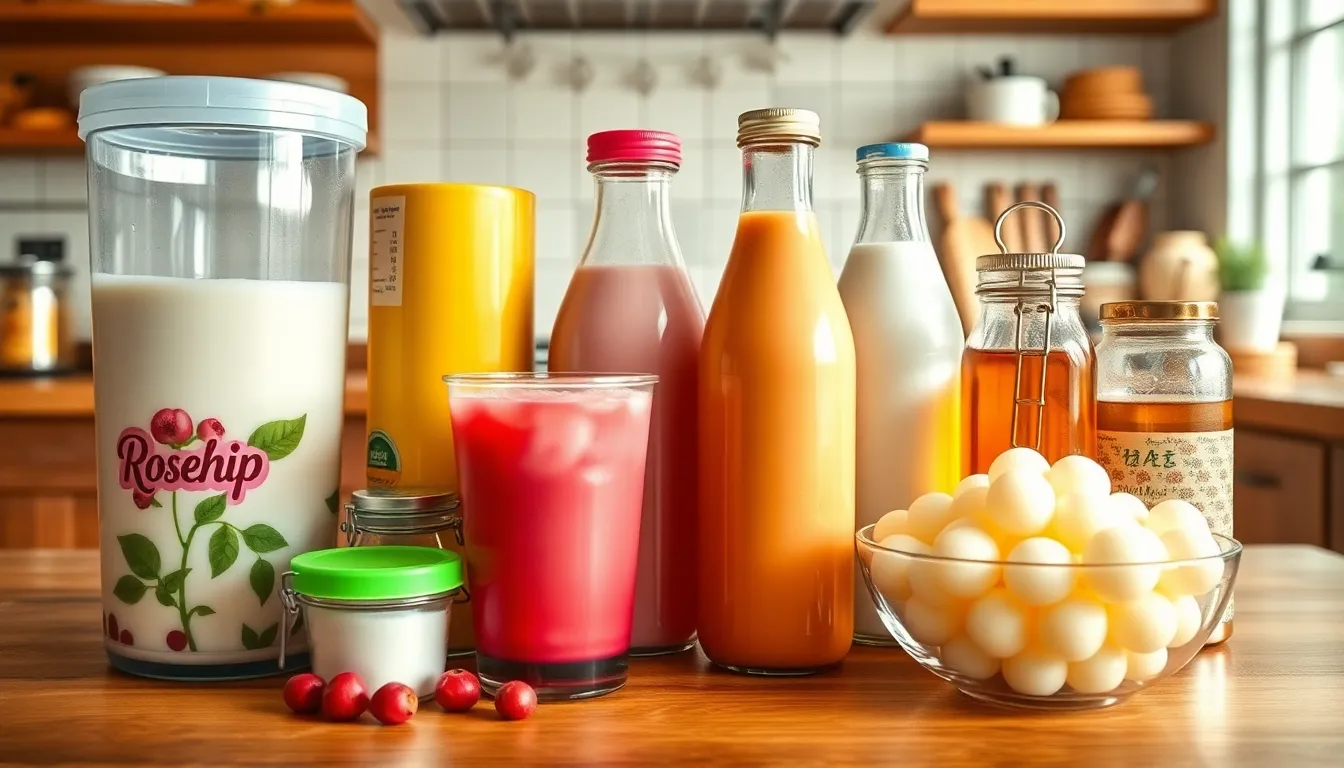
Proper storage extends the life of our rosehip milk tea while maintaining its vibrant flavor and nutritional benefits. We recommend consuming freshly prepared rosehip milk tea immediately for optimal taste and safety. But, understanding storage guidelines for each component helps us prepare efficiently and reduce waste.
Storing the Rosehip Tea Base
Our freshly brewed rosehip tea base stores best in the refrigerator for up to 4 hours when covered in an airtight container. We should strain out all plant material before refrigerating to prevent over-extraction and bitter flavors. The concentrate we prepare ahead maintains quality for up to one week when stored in a sealed glass container in the coldest part of our refrigerator.
Milk Storage Guidelines
Different milk types require exact storage approaches for food safety and quality retention:
| Milk Type | Storage Method | Duration |
|---|---|---|
| Dairy milk | Refrigerate at all times | Follow package date |
| Non-dairy milk (unopened) | Cool, dry pantry | Follow package date |
| Non-dairy milk (opened) | Refrigerate immediately | 7-10 days |
We always store dairy milk in the coldest section of our refrigerator to maximize shelf life and prevent spoilage. Non-dairy alternatives like oat or almond milk follow package instructions since some shelf-stable versions only require refrigeration after opening.
Boba and Tapioca Pearl Storage
Cooked tapioca pearls demand immediate attention for optimal texture. We store freshly cooked boba in an airtight container covered with sugar syrup and refrigerate immediately to prevent hardening. These prepared pearls maintain their best texture when used within 24 hours, though they remain safe for up to 7 days in the refrigerator.
Uncooked tapioca pearls store differently in our pantry. We keep unopened packages in a cool, dry place below 77°F. Once opened, we transfer pearls to an airtight container where they stay fresh for up to 7 days. For longer storage, we freeze uncooked pearls in airtight glass containers for up to 6 months.
Sweetener and Add-in Storage
Our sweeteners and flavor enhancers require dry storage conditions to maintain quality. We store sugar, honey, and rose petal powder in airtight containers away from moisture and heat sources. This prevents clumping and preserves flavor integrity for months.
Prepared flavor syrups keep in the refrigerator for up to two weeks when stored in clean, sealed containers. We label each container with preparation dates to track freshness and ensure food safety.
Complete Beverage Storage
We never recommend storing the complete assembled rosehip milk tea due to milk separation and texture changes. Instead, we store components separately and combine them fresh when serving. This approach maintains the drink’s creamy texture and prevents bacterial growth that occurs when milk sits at room temperature.
For bubble tea variations, we remove all boba before refrigerating the tea base and store pearls separately as described above. This prevents texture degradation and maintains food safety standards throughout storage periods.
Serving Suggestions

We recommend serving rosehip milk tea in clear glass mugs to showcase its stunning ruby-red color and create an Instagram-worthy presentation. The transparent vessel allows the beautiful hue to shine through while maintaining the drink’s temperature for optimal enjoyment.
Temperature Variations
Our preferred method involves serving this beverage warm during cooler months when you crave comfort and coziness. The heated version brings out the floral notes while the steam carries the aromatic compounds directly to your senses. During summer months we suggest chilling the prepared tea base and serving it over ice cubes for a refreshing afternoon treat.
Visual Enhancement
We love garnishing each cup with a light dusting of rose petal powder across the foam surface. This addition creates an elegant finish while complementing the natural floral undertones of the rosehips. Fresh rose petals make another beautiful garnish option that transforms your everyday drink into a cafe-quality experience.
Pairing Recommendations
Morning service pairs beautifully with light pastries or buttery croissants that won’t compete with the delicate rosehip flavors. Afternoon enjoyment works wonderfully alongside shortbread cookies or vanilla wafers that enhance rather than mask the drink’s natural sweetness. Evening consumption becomes more indulgent when served with dark chocolate squares that create a sophisticated flavor contrast.
Milk Alternatives for Different Occasions
We find that oat milk creates the creamiest texture and adds subtle sweetness that complements the tart rosehips perfectly. Almond milk offers a lighter option with nutty undertones that enhance the floral characteristics. Coconut milk transforms the drink into a more tropical experience while maintaining the nutritious benefits of the rosehip base.
Seasonal Serving Ideas
Winter service benefits from adding a cinnamon stick as both garnish and flavor enhancer that creates warming spice notes. Spring presentation looks stunning when served in vintage teacups with small flower arrangements nearby. Summer enjoyment reaches new heights when we add fresh mint leaves that provide cooling properties and visual appeal.
Variations and Substitutions
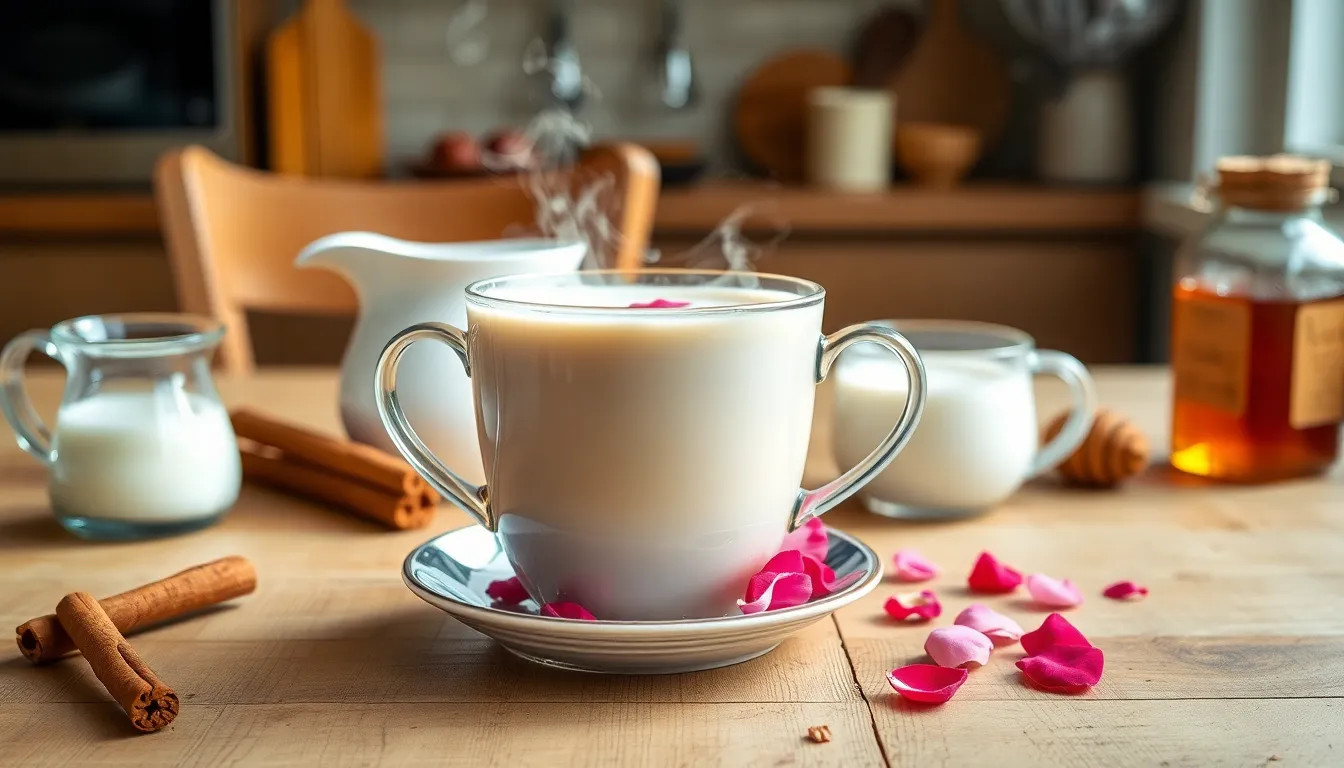
We can easily customize rosehip milk tea to match your dietary preferences and taste preferences. These adaptations maintain the drink’s signature ruby color and nutritional benefits while opening up new flavor possibilities.
Dairy-Free Options
Almond milk creates our most popular dairy-free version with its naturally creamy texture and subtle nutty undertones that complement rosehip’s tartness beautifully. We recommend using unsweetened varieties to control the final sweetness level.
Soy milk delivers a richer mouthfeel with its naturally occurring proteins that froth exceptionally well. This option provides a slightly sweeter base that pairs wonderfully with rosehip’s natural acidity.
Oat milk offers the closest experience to traditional dairy milk with its smooth and velvety texture. We find this creates the most luxurious dairy-free version that rivals any traditional milk tea.
Coconut milk brings tropical notes that create an entirely new flavor profile when combined with rosehips. Use the canned variety for maximum richness or carton versions for lighter drinks.
Sweetener Alternatives
Honey adds natural floral notes that enhance rosehip’s botanical character while providing gentle sweetness. We suggest starting with one teaspoon and adjusting to taste since honey’s intensity varies.
Maple syrup contributes rich and earthy undertones that create a more complex flavor profile. This option works particularly well in autumn and winter preparations.
Stevia provides zero-calorie sweetening for those monitoring sugar intake without compromising the drink’s health benefits. We recommend liquid stevia for easier blending and more consistent distribution.
Agave nectar offers a neutral sweetness that won’t compete with rosehip’s delicate flavors. This low-glycemic option dissolves easily in both hot and cold preparations.
Flavor Variations
Rose petals combined with rosehip create an intensely floral experience that transforms our basic recipe into an elegant botanical blend. We suggest using food-grade dried petals for the best results.
Vanilla extract adds warmth and creamy sweetness that makes each sip feel more indulgent. Just a few drops create noticeable depth without overwhelming the rosehip’s natural character.
Cinnamon brings warming spice notes that make rosehip milk tea perfect for cooler weather. We recommend using Ceylon cinnamon for its delicate sweetness rather than cassia’s more aggressive heat.
Fresh ginger provides gentle warming properties and digestive benefits that complement rosehip’s wellness aspects. Steep thin slices with your rosehip base for integrated flavor throughout.
Cardamom pods introduce exotic aromatic notes that elevate the entire drinking experience. Lightly crush 2-3 pods before adding them to your rosehip infusion for optimal flavor release.
Troubleshooting Common Issues

Even with careful preparation, our rosehip milk tea can sometimes present challenges. We’ve identified the most common issues and their answers to help you achieve the perfect cup every time.
Bitter or Overpowering Taste
When your rosehip milk tea tastes too bitter, we recommend reducing the steeping time to 5-7 minutes instead of the full 10 minutes. Another effective solution involves using less rosehip powder or fewer dried rosehips in your next batch. We suggest starting with 1 teaspoon of rosehip powder instead of 2 teaspoons, then gradually increasing until you reach your preferred flavor intensity.
Weak or Watery Consistency
A thin, watery texture typically indicates insufficient milk or an overly diluted rosehip base. We solve this by adding more milk to create the desired creaminess. For dairy-free options, we recommend using full-fat coconut milk or adding a tablespoon of non-dairy creamer to achieve better body and richness.
Lack of Flavor Depth
When your rosehip milk tea lacks the expected vibrant taste, we increase the steeping time to 8-10 minutes for a stronger infusion. Adding more rosehip syrup or powder during preparation also intensifies the flavor profile. We sometimes incorporate a pinch of rose petal powder to enhance the floral notes that make this beverage distinctive.
Gritty or Sediment Texture
Rosehip particles can create an unpleasant gritty mouthfeel if not properly strained. We always use a fine mesh strainer or tea infuser to remove all solid particles from our rosehip base. Double straining through cheesecloth ensures the smoothest possible texture for our finished beverage.
Temperature Issues
Milk that’s too hot can scorch and create an unpleasant taste, while milk that’s too cool won’t blend properly with the rosehip base. We heat our milk to approximately 150-160°F, creating the perfect temperature for smooth integration without compromising flavor.
Separation or Curdling
When milk separates or curdles in your rosehip milk tea, the rosehip base may be too acidic or hot. We prevent this by allowing our rosehip infusion to cool slightly before adding milk, and we always add milk gradually while stirring continuously to maintain proper emulsion.
Conclusion
We’ve discovered that rosehip milk tea isn’t just another trendy beverage – it’s a nutritional powerhouse that delivers both comfort and wellness benefits. This Nordic-inspired drink successfully bridges the gap between indulgent treats and health-conscious choices.
The versatility we’ve explored makes this tea suitable for any season or occasion. Whether you’re seeking immune support during cold months or a refreshing summer drink the adaptability ensures year-round enjoyment.
With proper preparation techniques and storage methods you’ll always have this ruby-red delight ready to serve. The customization options mean everyone can find their perfect version while maintaining the drink’s impressive health benefits.
Start brewing your own rosehip milk tea today and experience how this ancient Nordic tradition can enhance your modern wellness routine.
Frequently Asked Questions
What is rosehip milk tea?
Rosehip milk tea is a Nordic-inspired beverage that combines the tart sweetness of dried rosehip berries with creamy steamed milk. This caffeine-free alternative to traditional tea lattes features a vibrant ruby-red color and floral notes. The drink blends the distinctive tartness of rosehips with smooth milk, creating a uniquely satisfying beverage that bridges herbal wellness with indulgent comfort.
What are the health benefits of rosehip milk tea?
Rosehip milk tea is packed with vitamin C, providing exceptional immune system support and promoting healthy skin. The antioxidants in rosehips may reduce cold and flu duration, while offering cardiovascular benefits by helping lower cholesterol and blood pressure. The drink also provides anti-inflammatory properties that may help alleviate pain and serves as a natural energy booster.
How do you make rosehip milk tea?
To make rosehip milk tea, steep 2 teaspoons of rosehip powder or 1-2 tablespoons of dried rosehips in boiling water for 5-10 minutes. Strain the mixture and sweeten to taste. Heat 2 cups of your preferred milk separately, then combine the rosehip infusion with the warm milk. Stir well and serve hot, optionally garnished with rose petals.
Can you make iced rosehip milk tea?
Yes, you can make iced rosehip milk tea by following the same preparation steps but allowing the rosehip infusion to cool completely before combining with cold milk. Add ice cubes and stir well. The iced version retains all the nutritional benefits of the hot version while providing a refreshing alternative perfect for warm weather.
What equipment do you need to make rosehip milk tea?
You’ll need basic kitchen equipment including a tea infuser or fine mesh strainer, kettle or saucepan, measuring cups and spoons, serving cups, a mixing spoon, and optionally a milk frother or small whisk. Most home kitchens already have these essential tools, making rosehip milk tea an accessible beverage to prepare at home.
How long can you store rosehip milk tea?
Freshly prepared rosehip milk tea should be consumed immediately for best quality. However, you can store the rosehip tea base in the refrigerator for up to 4 hours, or prepare a concentrate that lasts up to one week. The complete assembled drink should not be stored as it can separate and spoil. Store components separately and combine fresh when serving.
What milk alternatives work best for rosehip milk tea?
Oat milk provides the creamiest texture closest to dairy milk, while almond milk offers a lighter, nutty flavor. Coconut milk adds a tropical twist, and soy milk provides a neutral base that doesn’t overpower the rosehip flavor. Each alternative maintains the drink’s signature ruby color while offering unique taste profiles to suit different preferences.
Can you add sweeteners to rosehip milk tea?
Yes, you can enhance rosehip milk tea with various sweeteners including honey, maple syrup, stevia, or agave nectar. Add sweeteners while the rosehip tea is still warm to ensure proper dissolution. Start with small amounts and adjust to taste, as rosehips naturally contain some sweetness that balances their tartness.
How do you fix bitter rosehip milk tea?
If your rosehip milk tea tastes bitter, reduce the steeping time to 3-5 minutes or use less rosehip powder. Over-steeping is the most common cause of bitterness. You can also add a touch of honey or maple syrup to balance the flavors, or dilute the tea with additional warm milk to mellow the intensity.
What are the best serving suggestions for rosehip milk tea?
Serve rosehip milk tea in clear glass mugs to showcase its beautiful ruby-red color. Garnish with rose petal powder or fresh rose petals for an elegant touch. Pair with light pastries for morning service, shortbread cookies for afternoon enjoyment, or dark chocolate squares for evening indulgence. The drink can be served hot or iced depending on the season.

